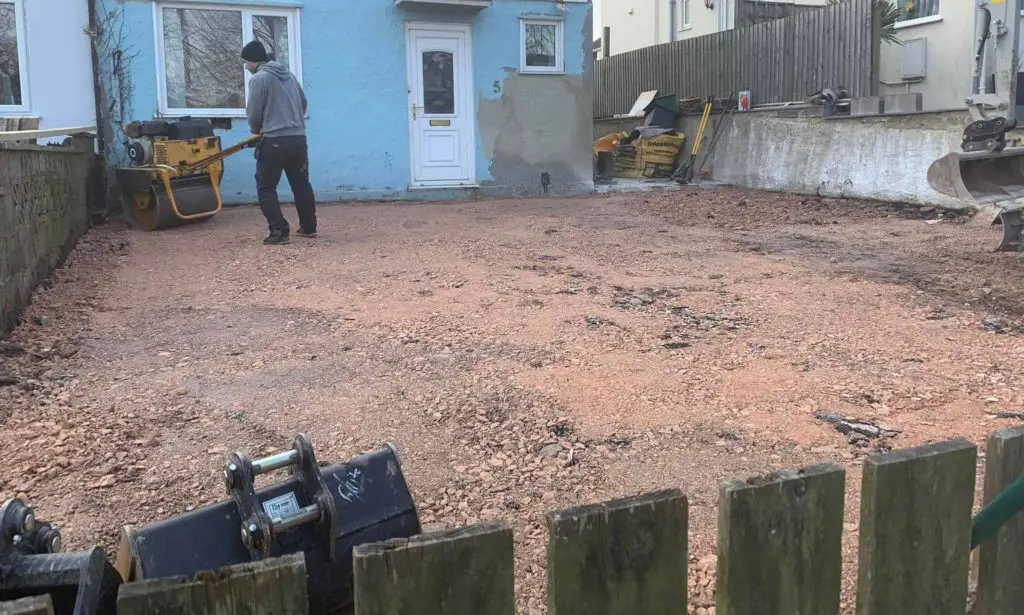Block Paving Depth, Sub-Base Calculation & Right Mortar for Edgings

For block paving, you’ve to excavate or dig first at a correct depth, plan on how much sub-base do you need, and have your sub-base right down there after the excavation, lay the edgings with a correct mixture, and then proceed with screeding the sand and laying the pavers.
These are some crucial steps in the process of laying block paving so it’s important to them right. Here’s our guide made with combining all these things so you can have everything in one place to proceed with the job.
How Deep to Dig for Block Paving
Firstly, you need to know what you are going to block pave. Is it for a driveway (vehicular traffic) or is it only for a pathway or patio (foot traffic)? If it’s for a driveway, you need more thickness of the sub-base compared to a patio or pathway.
You may have seen in many places that you need at least 200mm or 250mm excavation to lay block pavers for a driveway. 150mm for the sub-base, around 30-40mm for the compacted sand bed, and the remaining 50-80mm is where the pavers go depending on what block pavers you choose.
But obviously, how deep to dig in your case to lay block paving depends on the ground conditions. As said earlier, digging 200mm is normal in any condition to prepare a solid ground to lay the pavers on but sometimes you’ve to go much deeper to see the type of ground, for example, in the case of black clay you need more excavation.
Our updated, this block paving cheat sheet here, especially for DIYers covers the entire construction of block paving from how deep to dig to the thickness of the sub-base and material to use and to laying the blocks.
I’ve seen people digging all the way up to 450mm to remove all the topsoil and find a little hard ground for starting the sub-base up from there.
However, sometimes you can excavate less if you have the suitable ground right upfront but it’s recommended to dig at least 200mm (or should have a sub-base of 150mm) for a firm ground to lay pavers.
How deep you need to dig also depends on the thickness of your pavers. For example, you may need to dig slightly more if you’re going to lay 80mm pavers than usual which are 50mm thick. Hence, start calculating from the finish level of your paving to down such as pavers (50-80mm), sand bed (40-70mm), and sub-base (100-150mm).
Calculate How Much MOT Type 1 You Need for Block Paving Sub-Base
There is a formula for calculating how much sub-base or MOT type 1, to be specific, you need under your block paving. It’s the area of the paving x depth x 1.6-1.8.
One bulk bag of MOT Type 1 that’s of a ton will cover 10 square meters at 50mm depth and multiply that by 2-3 for an actual sub-base of 100-150mm depending on how much you need.
To cover 10m2 at 150mm which is a kind of normal thickness of sub-base for most driveways and it’s recommended to have at least 150mm thick sub-base, you’ll need around 3 bulk bags of MOT Type 1.
Hence, to take it in a real example, for a block paving of 50m2 (or around 50m2 MOT Type 1 sub-base at 150mm) you need roughly around 15 bulk bags of MOT Type 1.
Ideal Sand Bed Depth for Block Paving
After compacting the MOT Type 1, it’s important that you keep the sharp sand bed at the correct depth or thickness. Most people do a 50mm sand bed for laying the pavers, and it’s probably fine to go up to 50mm. However, it’s much better to keep it less deep at 20-30mm to ensure that you won’t give much space for the pavers to shift. Having 20-30mm of sharp sand under the pavers ensures that you’re not letting the pavers sink but also have a thick enough bed to handle the weight on the pavers at the same time.
If you are a DIYer doing block paving yourself, see the DIYers Cheat Sheet for Block Paving here, there’s a lot more you need to know during the process to give paving a better chance for success and longevity.
The Right Mortar Mix to Lay Block Paving Edgings
The importance of the edgings of paving is also as much as its sub-base, they will spread or move from their place because of inappropriate edging.
The best mix you will ever put the block paving edgings or kerbs with is 6-1 ballast cement. However, 3 parts of 10mm gravel, 2 parts of sharp sand, and 1 part of cement is also the best alternative mix to lay edges for block paving.
If you just use sharp sand and cement the same as the traditional mortar mix of laying edges, it’s eventually going to fail. To lay or fix the edges, you’ve to get them bedded on a bed that’s made from either any of the mortar mix mentioned earlier.
Let it be any type of edging, one thing to remember here is edging never goes on or never laid on the sand be. The edging is laid after excavation and before you add the mot type 1 for the sub-base so, you can pull the level off and begin with the further process.
After laying the edges, the next step is to prepare a sand bed to lay the pavers on. Here is a post that I wrote on how much sharp sand you need for block paving that you can check here.

Surely the edging is laid on one of the layers of type one? Not just on soil?
Also, what’s the reason you use a ballast mortar mix to lay the edging as opposed to building a concrete footing and laying on that with sharp sand?
Thanks